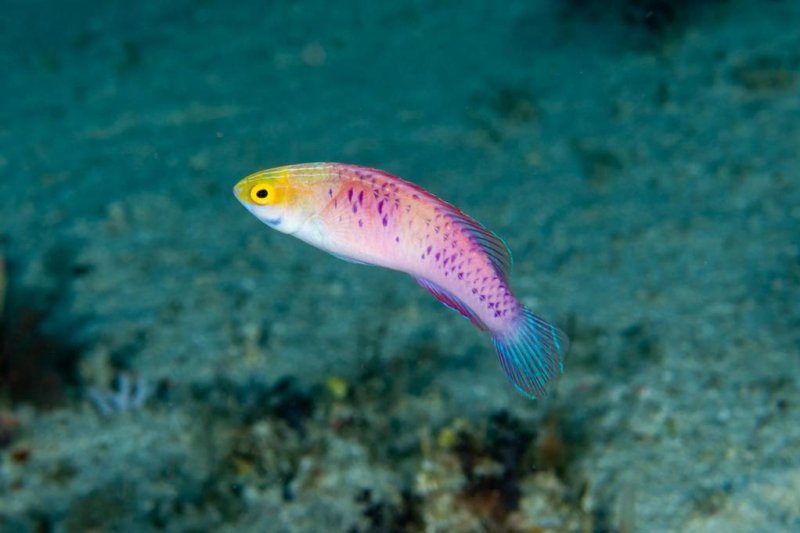The scientific and common names granted to a new species of reef fish found swimming of the coast of Tanzania pay tribute to the blockbuster film Black Panther. Photo by Luiz Rocha/California Academy of Sciences
July 11 (UPI) -- Scientists have discovered a new species of reef fish swimming 200 feet beneath the ocean surface, just off the coast Tanzania.
The colorful species' scientific name, Cirrhilabrus wakanda, is a tribute to the fictional home nation of Marvel superhero Black Panther. The fish's common name, vibranium fairy wrasse, is an homage to the fictional metal mined in Wakanda.
The new species prefers reefs found in the so-called twilight zone of the ocean. Only a small amount of sunlight filters its way down to the twilight zone. Though its surroundings are dimly lit, the vibranium fairy wrasse sports deep purple scales, as well as bright pink, yellow and blue accents.
Researchers with the California Academy of Sciences and the University of Sydney spotted the new species will diving in eastern Zanzibar. They described their discovery this week in the journal ZooKeys.
"When we thought about the secretive and isolated nature of these unexplored African reefs, we knew we had to name this new species after Wakanda," Yi-Kai Tea, an ichthyologist and doctoral student at the University of Sydney, said in a news release. "We've known about other related fairy wrasses from the Indian Ocean, but always thought there was a missing species along the continent's eastern edge. When I saw this amazing purple fish, I knew instantly we were dealing with the missing piece of the puzzle."
Researchers were able to collect specimens of the new species and examine them in the lab. Scientists studied the scales, fin rays and body structures under a microscope. They also sequenced the species' DNA, confirming its uniqueness from its relatives in the western Indian Ocean and Pacific.
Visiting the mesophotic reefs of the twilight zone is dangerous, which is why regulations forbid recreational diving at such depths. Significant training and special equipment is required.
"Preparation for these deep dives is very intense and our dive gear often weighs more than us," said Luiz Rocha, academy curator of fishes with the California Academy of Sciences' Hope for Reefs initiative. "When we reach these reefs and find unknown species as spectacular as this fairy wrasse, it feels like our hard work is paying off."
Because mesophotic reefs are so hard to reach, less is known about the diversity of life living within them. But research suggests the ecosystems host a variety of species, many of which are vulnerable to the same risks facing shallower coral reefs.
"It's a time of global crisis for coral reefs, and exploring little-known habitats and the life they support is now more important than ever," said Rocha. "Because they are out of sight, these deeper reefs are often left out of marine reserves, so we hope our discoveries inspire their protection."















